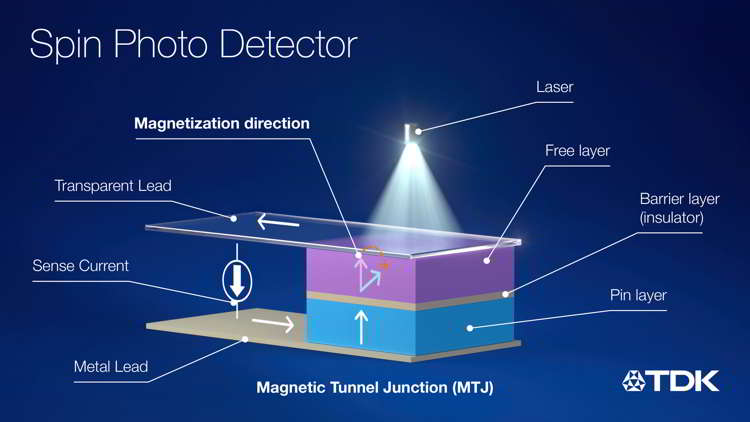TDK Demonstrates Spin Photo Detector Capable of 10X Data Transmission Speeds for Next-Gen of AI
At ultra-high speeds of 20 picoseconds using light with 800 nm wavelengths, 10X faster than conventional semiconductor-based photo detectors
This is a Press Release edited by StorageNewsletter.com on April 16, 2025 at 2:00 pmSummary :
- A photo-spintronic conversion element capable of responding at ultra-high speeds of 20 picoseconds using light with 800 nm wavelengths, 10X faster than conventional semiconductor-based photo detectors
- Concepted and developed by TDK, the magnetic device can detect both near-infrared and visible light
- Successfully demonstrated operation in collaboration with Nihon University in Japan, known for fundamental physics research
- It can be applied to photoelectronic conversion technology, which is expected to improve data processing speed and reduce power consumption, both critical for further AI evolution
TDK Corporation announces that it has developed the world’s first (*) ‘Spin Photo Detector,’ a photo-spintronic conversion element combining optical, electronic, and magnetic elements that can respond at an ultra-high speed of 20 picoseconds (20 × 10⁻¹² s) using light with a wavelength of 800nm [1] – more than 10X faster than conventional semiconductor-based photo detectors.
This new device is expected to be a key driver for implementing photoelectric conversion technology that boosts data transmission and data processing speed, particularly in AI applications, while simultaneously reducing power consumption.
Transferring mass amounts of data at higher speeds and with lower power consumption is an inevitable need as AI evolves. To process data and make calculations, data is currently transferred between CPU/GPU chips as well as from and to memory by electrical signals. Therefore, there is an increasing need for optical communication and optical interconnects, which offer high speeds that do not decrease with interconnect distance. Photoelectronic conversion technology is also gaining global interest as a very compact fusion of both optical and electronic elements.
To address these challenges, TDK adapted its magnetic tunnel junction (MTJ) technology, which is currently used in billions of HDD heads, for photonics. One of the major advantages of this technology is that it does not require crystal growth using a single crystal substrate, and the device can be formed regardless of the substrate material. Comparatively, conventional semiconductor-based photo detectors have physical limitations at shorter wavelengths. Because the Spin Photo Detector has a completely different operating principle and uses an electron heating phenomenon, it can operate at ultra-high speeds even when the wavelength is shortened [1]. In addition, the operating wavelength range is wide, and it has been confirmed that it can operate from visible light to near-infrared light. TDK has successfully demonstrated the Spin Photo Detector with Nihon University in Japan, a research pioneer for the measurement of ultrafast phenomena of magnetic material.
Additionally, with the ability to detect visible light at high speeds, the spin photo detector will be useful in applications projected for future growth, such as devices for AR/VR smart glasses ([2], [3]) and high-speed image sensors. While conventional semiconductor photo-sensing devices have weak cosmic-ray resistance, MTJ elements are also known for their strong cosmic-ray resistance and are expected to be used as light-detecting elements in aerospace applications. In the future, based on these results, TDK will improve the perfection of the high-speed light detection element to further pursue its usefulness.
(*) As of April 2025, according to TDK research
[1] J. Phys. D: Appl. Phys. 58 06LT01 (2025), “Spin photo detector by using a CoFeB magnetic tunnel junction”
[2] Exhibitions: TDK showcases smart glasses equipped with ultra-compact full color laser module at major exhibitions
[3] TDK develops world’s first full-color laser control device for 4K smart glasses















 Subscribe to our free daily newsletter
Subscribe to our free daily newsletter


